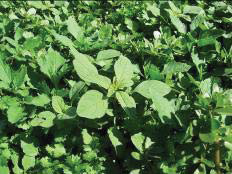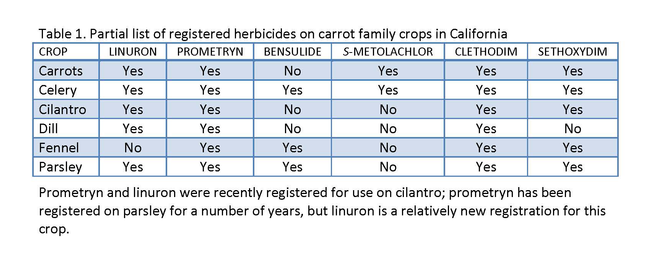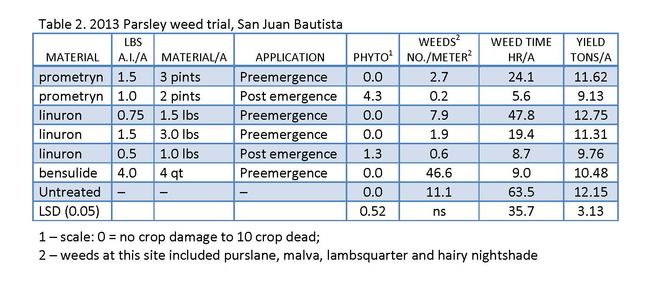From the Cooperative Extension Monterey County Crop Notes newsletter :: Mar-Apr 2015
The Apiaceae or carrot family includes important vegetable crops such as carrots, celery, cilantro, dill, fennel and parsley. All of these crops have a distinctive inflorescence known as an umbel. They also produce aromatic oils that give these plants their characteristic aromas and flavors. Many of these crops germinate slowly and are quite susceptible to weed pressure early in the production cycle. As a result, crops like celery are nearly 100% transplanted to give the crop a head start in the production cycle and on the weeds. However, other crops in this family such as carrots, cilantro and parsley are direct seeded in dense stands on 40 or 80 inch wide beds; dense plantings limits the use of mechanical cultivation for weed control, thereby increasing the need for other weed control strategies. Cultural practices can provide significant weed control; practices such as careful field selection and rotations, as well as pre-irrigation followed by cultivation can significantly reduce weed pressure in production fields. Carrot, cilantro and parsley seed germinate slowly which creates an opportunity to burn off an initial flush of weeds (with an herbicide or propane flaming) following planting but prior to the emergence of the crop. This is a tricky, but effective technique for reducing weed density. Starting with low weed pressure in the production field is exceedingly helpful in reducing subsequent hand weeding costs no matter the weed control strategies that are employed.

In general, carrot family crops respond similarly to linuron and prometryn. Both material are in different chemical families (linuron, substituted urea and prometryn, triazone), but are both photosystem II inhibitors. However, in trials conducted over the past few years, we have noticed that some of the carrot family crops respond differently to these herbicides. For instance, linuron is exceedingly safe for use on carrots preemergence and post emergence. Prometryn is also safe for preemergence use on carrots; at higher post emergence rates we have noticed yellowing of the carrot foliage, but no difference in yield was observed between preemergence and post emergence applications of prometryn. In cilantro and parsley, preemergence applications of both linuron and prometryn are safer than post emergence applications. Fennel showed the most dramatic difference in response between linuron and prometryn. In a screening trial evaluating linuron and prometryn on fennel the post emergence application of prometryn was very safe on the crop, but linuron reduced the growth of this crop at the rates used in the trial. Linuron is not yet registered on fennel, but it is clear that we will need to evaluate lower rates on this crop for post emergence use.
Gratefully, the list of weed control options for carrot family crops has increased. Carrot family crops are a unique and challenging group in which to manage weeds. Slow initial growth and high density plantings increases the challenge of controlling weeds. However, with an integrated approach of cultural, mechanical and chemical weed control options good weed control can be achieved on this important group of crops.

